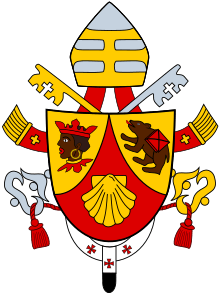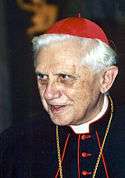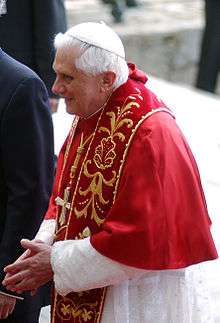Spe Salvi
| Spe Salvi (Latin: Saved in Hope) Encyclical letter of Pope Benedict XVI  | ||||
|---|---|---|---|---|
| ||||
| Date | 30 November 2007 | |||
| Argument | Hope and Salvation | |||
| Pages | 77 | |||
| Encyclical number | 2 of 3 of the pontificate | |||
| Text | in Latin in English | |||
| Part of a series on the |
| Theology of Pope Benedict XVI |
|---|
 |
|
|

Spe Salvi (English: "Saved in Hope"), referencing the Latin phrase from Romans 8:24, Spe salvi facti sumus ("in hope we were saved"), is the second encyclical letter by Pope Benedict XVI promulgated on November 30, 2007, and is about the theological virtue of hope. Benedict has systematically touched upon the three theological virtues: love in 2005 Deus caritas est ("God is Love"), hope in this encyclical, and faith in 2013 Lumen fidei ("The Light of Faith"), written with Pope Francis.[1]
The encyclical contains over 18,900 words, divided into fifty paragraphs, and organized into an introduction and eight chapters.
Title
As is customary for papal encylicals, the Latin title of Spe Salvi comes from its incipit, which quotes St. Paul's Epistle to the Romans: "For we are saved by hope. But hope that is seen is not hope. For what a man seeth, why doth he hope for?"[Rom 8:24] In the introduction of the encyclical, Benedict sets the tone of his text by asking about the relationship between hope and redemption.
In paragraph seven, he proceeds to link these two Christian concepts to the theological virtue of faith by analyzing the Greek and Latin translation of: Est autem fides sperandarum substantia rerum, argumentum non apparentium.
Summary
Benedict traces relationship between the Christian concept of hope and redemption. The first six chapters are theological in nature, but often use historical examples to highlight applications to daily life. Benedict starts by quoting St. Paul's reminder to the early Church community that before converting to Christianity, they were "without hope and without God in the world" (Epistle to the Ephesians 2:12). Benedict describes Christian hope as transformative because it offers assurance that "life will not end in emptiness". Benedict relates the story of Josephine Bakhita as an example of the contrast between a prior, pagan way of life and the new "hopeful" Christian life. Josephine, an African saint who lived her early life as a slave, converted to Catholicism after finding "the great hope" which had "redeemed" her. She spent the rest of her life as a nun, preaching throughout Italy and was canonized in 2000.[2]
| “ | I remember how, as a child, when I contemplated the sun, the moon, the stars, and all the beautiful things of nature, I was wondering, ‘who is the master of it all?’ And I felt a keen desire to see Him, to know Him and to pay Him homage.[3] | ” |
Paragraphs four, five, and six describe a series of contrasts that serve to clearly define Christ's role as revolutionary in the Roman empire and its implications for Christians. Benedict draws clear distinction between the failed socio-political revolutions or liberations of Spartacus, Barabbas, and Bar-Kochba with "the new (non-political) hope" of Jesus. He concludes that Jesus brought "an encounter with the Lord of all lords, an encounter with the living God and thus an encounter with a hope stronger than the sufferings of slavery, a hope which transformed life and the world from within", something that these revolutionaries could not. These paragraphs recall Benedict's persistent rejection of Marxism and Liberation Theology throughout his teachings and specifically in Deus caritas est.[4] Benedict then draws on early Christian sarcophagi representations of Jesus as philosopher and shepherd to illustrate that Christian hope extends beyond life on earth.
In the chapter "Eternal life – what is it?" Benedict deals with the topic of eternal life, explaining that it is not a mere prolongation of existence but the blissful completion of life. In the next chapter, "Is Christian hope individualistic?", he mentions theologians like Henri de Lubac and such mystics as Augustine of Hippo, Bernard of Clairvaux, and Benedict of Nursia. In the chapter "The transformation of Christian faith-hope in the modern age", Francis Bacon, Immanuel Kant, Friedrich Engels and Karl Marx appear with respect to the relationship between faith and reason.
In the chapter "The true shape of Christian hope" Benedict cites Vladimir Lenin, Karl Marx and Theodor W. Adorno, while in "Settings for learning and practising hope" he mentions with reference to, among others, Cardinal Nguyen Van Thuan, the philosopher Max Horkheimer, Fyodor Dostoyevsky and Plato. The encyclical closes with the chapter "Mary, Star of Hope".
References
- ↑ Speciale, Alessandro (4 July 2013). "The light of faith: origin, history and horizon of the christianism". La Stampa. Turin. Retrieved 19 October 2013.
- ↑ Spe Salvi - Encyclical Letter of His Holiness Benedict XVI on Christian Hope
- ↑ St. Josephine Bakhita
- ↑ Paragraphs 26-27
External links
- Full text of the encyclical in English
- Full text of the encyclical in other languages
- Benedict waxes lyrical on hope in National Catholic Reporter
- Audio recording of Spe Salvi The recording can be downloaded on H2onews website and is available in Spanish, English, French, Italian, German and Portuguese. And it is soon to be made available in Chinese and Arabic.

